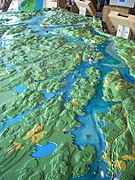Earth:Joint valley landscape
Joint valley landscape or fissure valley terrain (Swedish: sprickdalslandskap, sprickdalsterräng) is a type of relief common in Fennoscandia. The landscape originates from the erosion of joints in the bedrock which leaves out small plateaus or ridges in between.[1] When the block summits in joint valley landscape are of different height it may indicate the past movement of a vertical geological fault.[1]
Karna Lidmar-Bergström identified joint valley landscape areas centered on Blekinge, Bohuslän, Linköping/Västervik, Stockholm and Hudiksvall. In the last three areas the flat summits of the landscapes are parts of the Sub-Cambrian peneplain. In addition to this there is a large-scale joint valley landscape that extends from the High Coast inland.[2] The landscape type was first identified by Sten De Geer who in 1926 called it rutplatåland (lit. square plateau land).[3][4] Joint valley landscapes are among the few places in southern Sweden where there are steep slopes in excess of 25°.[5]
Gallery
References
- ↑ Jump up to: 1.0 1.1 (in sv) Terrängformer i Norden. Nordiska ministerrådet. 1984. p. 9.
- ↑ Lidmar-Bergströrm, Karna (1995). "Relief and saprolites through time on the Baltic Shield". Geomorphology (Elsevier) 12: 45–61.
- ↑ De Geer, Sten (1926). "Norra Sveriges landforms-regioner" (in sv). Geografiska Annaler (Swedish Society for Anthropology and Geography) 8: 125-136.
- ↑ "Regionindelning" (in sv). Utredning angående Norrlands näringsliv. Förberendade undersökning verkställd av 1940 års norrlandsutredning. Statens offentliga utreningar. 39. Stockholm: Jordbruksdepartamentet. 1943. p. 21. https://data.kb.se/datasets/2015/02/sou/1943/1943_39(librisid_13537711).pdf/.
- ↑ Embleton, C., ed (1997). "Sweden". Geomorphological Hazards of Europe. Elsevier. p. 457. https://archive.org/details/geomorphological00embl.
 |




